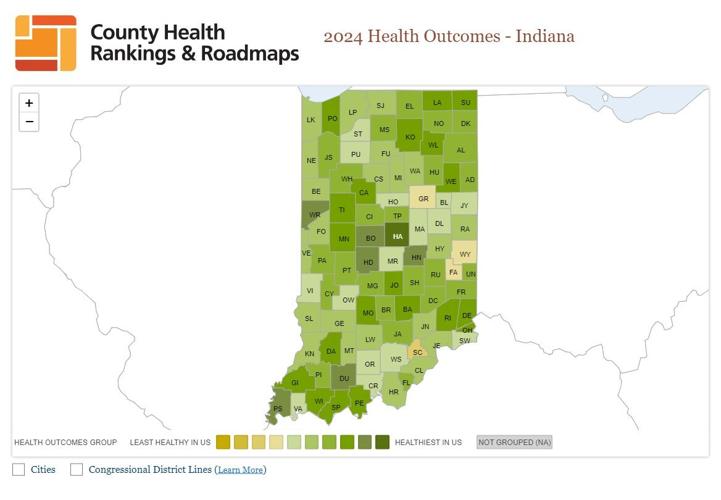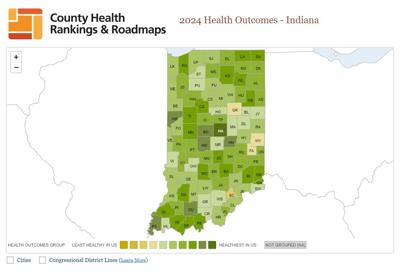People cross paths with familiar faces in grocery stores, restaurants and sporting events every day.
“How’s it going?” they might ask.
“Oh, livin’ the dream,” often is the response.
Or, as most of us figure out with age, those superficial greetings might turn into a recitation of aches, pains and ills, especially in Vigo County.
The annual County Health Rankings and Roadmaps calculations by the University of Wisconsin Population Health Institute and the Robert Wood Johnson Foundation, released this spring, are a reminder of the Terre Haute area’s continuing struggle toward better health.
It’s a stark wakeup call, year after year. Vigo ranked 63rd in overall health among 92 Indiana counties last year. As of this year, UW no longer attaches an overall ranking for counties, but the subcategories reveal the usual local concerns.
Compared to most other Hoosiers and Americans, Vigo Countians more often die prematurely, endure poor mental and physical health days, deliver low birthweight babies, contract sexually transmitted infections, give birth as teenagers, experience in poverty as kids and breathe polluted air, according to the rankings.
A few trends in Vigo County stand out, in terms of issues leading to poor health and well-being.
Vigo has the least-favorable score in the food environment index, which includes the percentages of the population with limited access to healthy foods and experiencing food insecurity. Twenty percent of Vigo Countians have a limited access to healthy food, and folks who live in such food deserts tend to have higher rates of obesity and premature deaths. Fourteen percent of Vigo residents live with food insecurity, lacking a constant supply of balanced meals.
Vigo also ranks among the four least healthy Indiana counties in preventable hospital stays (fourth from the bottom), childcare cost burden (also fourth worst) and median household income (third lowest).
The 2024 County Health Rankings aren’t a total downer for the community, though. Vigo has the seventh-best ratio of primary care physicians per resident, with one family doctor for every 1,200 people. Also, in a nuanced education category, Vigo ranks in the upper third of Hoosier counties for high school completion, with 90% of adults ages 25 and older with a high school diploma or an equivalency degree. It’s a different story for high school graduation; Vigo ranks next-to-last with just 77% of the ninth-grade cohort graduating in four years.
One bright spot seems surprising, given Vigo’s struggles with poor health factors and outcomes — we generally like to socialize. Vigo County has 14.4 membership organizations per 10,000 people. Those include civic, political, religious, sports or professional organizations. That ratio beats that of the state (11.6) and nation (9.1). Vigo’s social associations rate could likely have been even higher, if not for the county’s chronically weak voter participation levels.
The UW Population Health Institute’s annual “National Findings Report” emphasizes the importance of community interactions in improving residents’ health and well-being. Communities that gather often live better, usually.
“Evidence shows that participating in our communities, whether through volunteering or joining neighborhood groups, strengthens our social connections and sense of belonging, which in turn benefits our physical and mental health,” the report states.
“Civic participation in political or electoral processes through voting or organizing can also influence policies that create opportunities for health, including safe spaces to live and work, and funding for public-health initiatives.”
It’s essentially getting to know your neighbors.
“When people are connected, they form networks,” Ericka Burroughs-Girardi, research program coordinator for the County Health Rankings, said last week by phone. People then can more easily find emotional or social support. They may grow more inclined to join groups with people of different backgrounds.
“People are more likely to stretch themselves, and learn about other people, if they connect with them,” Burroughs-Girardi said.
But, as she pointed out, “social associations are just one area.”
“In order for communities to thrive, there have to be opportunities to have a living wage,” Burroughs-Girardi said, as well as upward mobility through education, and other social and economic factors. “As people have better opportunities for education, they’re able to make better job choices.”
The County Health Rankings report cited the importance of funding for public-health initiatives, and Vigo County has recently benefited in that realm.
Indiana’s new Health First Initiative — pushed by Gov. Eric Holcomb’s post-pandemic commission to study the state’s dismal public health funding — provides $75 million to be distributed this year to the 86 counties that wisely opted to receive those funds. Another $150 million will be disbursed in 2025, when counties will need to match 20% of their share of the funding. Vigo County receives $1.28 million this year, and double that next year.
Locally, Health First Initiative funds help enhance the county Health Department’s staffing and services, but do much more. Funding will address entrenched problems in mental health issues and addiction, including residents in the judicial system or incarcerated. It will assist children in the Vigo County School Corporation, including those involved in the county’s family court system. They’ll get life skills assistance, health and wellness instruction, therapy and other services.
Those additional resources could help more kids graduate from high school on time.
And then this annual snapshot of Vigo County’s health and well-being will look significantly brighter.























Commented
Sorry, there are no recent results for popular commented articles.